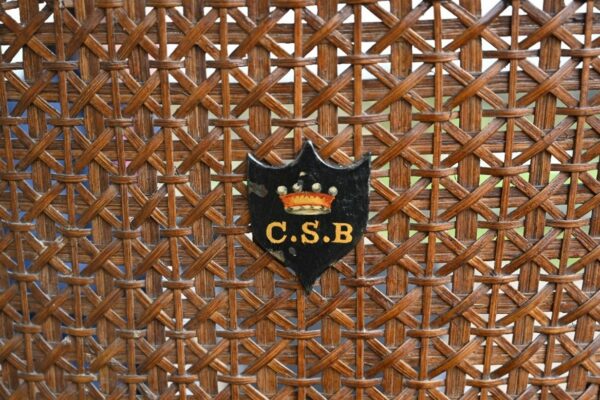You might have spotted a cart hanging in the lobby area of the Coach House, which is home to Raby’s new shop and exhibition space. A particular favourite of the Raby team, this cart was primarily for recreation rather than a means of transport, and evidence in our archives and collections show that it was well used and loved.

These smaller carts, which were lightweight and suited for one rider, were often referred to as a ‘chair’ or a ‘whiskey’. They were named after the ability of the cart to whisk someone around and quickly pass by other carriages. A ‘curricle’ was a similar vehicle used by young men about town, and due to their speed and manoeuvrability acted as a kind of early sports car. In contrast, the one at Raby was used at a more leisurely pace when traversing large parks and gardens in fair weather.
This emphasis on leisure can be seen in the build of the cart. The caned seat and plush leather cushion would have offered a comfortable ride, and the leather guards protected the rider from mud splatters from the wheels. The front board- known as a dashboard- prevented them from being splashed with dirt ‘dashed up’ from the horse. It was also helpful for making sure they wouldn’t have to see the horse’s rear! The holder at the top of the dashboard was for resting the reigns, and the holder to the side of the chair was for a crop.


The makers mark on the wheel hub, ‘Davis & Sons, Battle’ gives some indication as to the origin of the cart.

Battle Abbey, now run by English Heritage, was the home of the 4th Dowager Duchess of Cleveland after her husband the 4th Duke died childless in 1891. The 9th Baron Barnard took over the running of Raby Castle, and the 4th Duchess moved to their other home at Battle Abbey. She still visited Raby, as seen in the castle’s visitor books.
We have a photograph in the collection of the 4th Duchess, in what appears to be our cart, in front of the entrance to Battle Abbey.

An inscription on the back of the photograph calls the cart ‘the donkey carriage’, and the 9th Baroness Barnard kept this tradition of using a donkey as her trusty steed. Here, Catherine Sarah is pictured in a similar position in front of Raby Castle, with a donkey held by a groom or a pony boy. The Lady Barnard used the cart for travelling around Raby’s parkland to areas such as Bath Wood.

A small shield seen on the back of the cart reads ‘CSB’ and includes the Baron’s Coronet.

The painted shield added by the Lady Barnard is just one indication that the cart was well loved. The cart is often seen in photographs, including this image from 1907 of the cart in front of a car rally, which provides an interesting contrast between the changing modes of transport at the turn of the century.

The cart can also be spotted in the Raby Castle visitor books, a place where visitors would recount their experiences when visiting the family. These photographs show the 9th Lady Barnard sharing the the cart with friends.

Lady Barnard’s frequent use of the cart is also shown in the 9th Lord Barnard’s pocket diaries. The cart offered increased accessibility to the outdoors at times when Lady Barnard was ill, prior to her death in 1917. The Lord and Lady Barnard would take walks around the park, with Catherine travelling her chair.
April 18th 1914: ‘Brilliant day… Went out with C. (pony chair) Lady Close Wood.’
The cart has now found a new purpose welcoming visitors into the Coach House. In preparation for its’ new position after time spent in storage, the cart required conservation treatment. Alongside a surface clean, areas of historic damage had to be managed and the leather seat had to be frozen as a preventative measure against pests. Leatherwork, such as the mud guards, was treated and restored, varnish on painted wood was reset, and active corrosion was removed from the wheels.



The positioning of the cart within the lobby posed the next interesting challenge. Raby worked with Ian Watson and his team at Open Format to determine the safest way to hang the cart, both for those standing beneath and also for the integrity of the structure. A bespoke hanging system was designed to ensure the weight was balanced in a way that was most natural for the cart.
We think the pony cart offers an impressive welcome to the Coach House, combining the new and interesting designs of the current Rising developments while still celebrating the heritage and use of the buildings.


